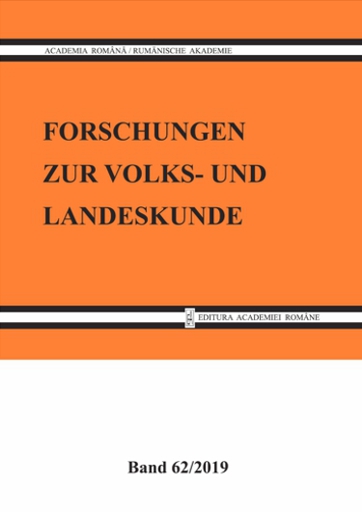Zwei Prager Soziolekte ‚Kucheldeutsch‘ und ‚Kuchelböhmisch‘ als Resultat deutsch-tschechischer Sprachkontakte. ‚Kucheldeutsch‘, der Unterstädter Soziolekt von Hermannstadt
Two Prague Sociolects ‘Kucheldeutsch’ (“Kitchen German”) and ‘Kuchelböhmisch’ (“Kitchen Bohemian”) Resulting from Linguistic Contacts of German and Czech. ‘Kucheldeutsch’ (“Kitchen German”), the Sociolect of the Lower Town of Sibiu
Author(s): Sigrid HaldenwangSubject(s): Language and Literature Studies, Sociolinguistics
Published by: Editura Academiei Române
Keywords: Sociolect; German-Czech linguistic contacts; Kucheldeutsch (German with Czech phonetic elements and loan words); Kuchelböhmisch (Czech with German loan words); Kucheldeutsch in Sibiu;
Summary/Abstract: The first part of this paper relates to the two sociolects which arose from German-Czech language contacts. The 19th century was a decisive time for these sociolects, when Prague's industrialisation attracted many workers from the surrounding areas of the Czech capital. They generated a sociolect called ‘Kucheldeutsch’ (a German with Czech phonetic elements and loan words) that they spoke with their German authorities, belonging to the German-speaking bourgeoisie who lived there in the diaspora. ‘Kuchelböhmisch’ (Czech with German loan words) developed, when, during the second half of the 19th century, many Bohemians emigrated to Prague as well as to Vienna, the centre of the Danube Monarchy, to work there due to an agricultural crisis. Most of them didn't speak German, but were forced to make their way in a foreign environment. They acquired their linguistic skills in daily contact with German-speaking employers and colleagues and thus adopted some of their words and idioms or they listened to their German neighbours chatting. The second part of this paper relates to the ‘Kucheldeutsch’ spoken in Sibiu in the past. It is a strange mixture of vernacular and colloquial and is difficult to define. The speakers of this language mixture were mostly craftsmen but also from the lower social classes. They were always multi-linguals: With intellectuals and strangers they spoke Transylvanian-Saxon colloquial, which followed the educated language from the upper town of Sibiu. When conversing with family members and among themselves they used a mixture of said colloquial, Austrian and other local linguistic factors which cannot be defined. This language mixture was also affected by Austrian colloquial spoken by the soldiers, officers and officials of the Austrian Monarchy who brought their language to Transylvania. Finally, it is concluded that, while the Czech and German sociolects „Kuchelböhmisch“ and „Kucheldeutsch“ spoken by the Prague lower classes verifiably influenced the language of the urban German-speaking bourgeoisie and the sociolect lexemes were included in the Prague dictionaries of German, the Sibiu version of „Kucheldeutsch“ was restricted to craftsmen and lower social classes. The great exodus of Transylvanian Saxons after the Communist fall in Romania has taken away most of the sociolect's speakers. There is no record of the few remaining speakers. At the end of the paper on Sibiu ‘Kucheldeutsch’ there are several case examples concerning its lexis and phonetics.
Journal: Forschungen zur Volks- und Landeskunde
- Issue Year: 2019
- Issue No: 62
- Page Range: 109-116
- Page Count: 8
- Language: German
- Content File-PDF

